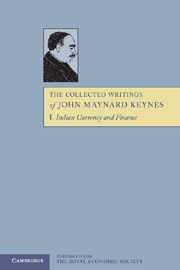Book contents
- Frontmatter
- Contents
- General introduction
- Editorial foreword
- Preface
- Dramatis personae
- 1 THE PRESENT POSITION OF THE RUPEE
- 2 THE GOLD-EXCHANGE STANDARD
- 3 PAPER CURRENCY
- 4 THE PRESENT POSITION OF GOLD IN INDIA AND PROPOSALS FOR A GOLD CURRENCY
- 5 COUNCIL BILLS AND REMITTANCE
- 6 THE SECRETARY OF STATE'S RESERVES AND THE CASH BALANCES
- 7 INDIAN BANKING
- 8 THE INDIAN RATE OF DISCOUNT
- Index
- Chart showing the rate of discount at the Presidency Bank of Bengal
2 - THE GOLD-EXCHANGE STANDARD
Published online by Cambridge University Press: 05 November 2012
- Frontmatter
- Contents
- General introduction
- Editorial foreword
- Preface
- Dramatis personae
- 1 THE PRESENT POSITION OF THE RUPEE
- 2 THE GOLD-EXCHANGE STANDARD
- 3 PAPER CURRENCY
- 4 THE PRESENT POSITION OF GOLD IN INDIA AND PROPOSALS FOR A GOLD CURRENCY
- 5 COUNCIL BILLS AND REMITTANCE
- 6 THE SECRETARY OF STATE'S RESERVES AND THE CASH BALANCES
- 7 INDIAN BANKING
- 8 THE INDIAN RATE OF DISCOUNT
- Index
- Chart showing the rate of discount at the Presidency Bank of Bengal
Summary
If we are to see the Indian system in its proper perspective, it is necessary to digress for a space to a discussion of currency evolution in general.
My purpose is, first, to show that the British system is peculiar and is not suited to other conditions; second, that the conventional idea of ‘sound’ currency is chiefly derived from certain superficial aspects of the British system; third, that a somewhat different type of system has been developed in most other countries; and fourth, that in essentials the system which has been evolved in India conforms to this foreign type. I shall be concerned throughout this chapter with the general characteristics of currency systems, not with the details of their working.
The history of currency, so far as it is relevant to our present purpose, virtually begins with the nineteenth century. During the second quarter of this century England was alone in possessing an orthodox ‘sound’ currency on a gold basis. Gold was the sole standard of value; it circulated freely from hand to hand; and it was freely available for export. Up to 1844 bank notes showed a tendency to become a formidable rival to gold as the actual medium of exchange. But the Bank Act of that year set itself to hamper this tendency and to encourage the use of gold as the medium of exchange as well as the standard of value. This Act was completely successful in stopping attempts to economise gold by the use of notes.
- Type
- Chapter
- Information
- The Collected Writings of John Maynard Keynes , pp. 11 - 25Publisher: Royal Economic SocietyPrint publication year: 1978



